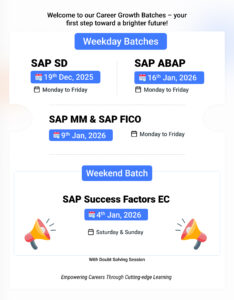Global Recognition of SAP
Introduction
In an increasingly interconnected world, the ability of organizations to leverage technology for enhanced operational efficiency has never been more crucial. Software Applications and Products, commonly known as SAP, has emerged as a global leader in enterprise resource planning (ERP) software. With a commitment to integrating various business processes and optimally managing resources, SAP’s influence stretches across industries, regions, and organizational sizes. This essay delves into the global recognition of SAP, examining its impact on business practices, the strategic advantages it offers, the challenges it faces, and its future trajectory in a rapidly evolving technological landscape.
The Evolution of SAP
Founded in 1972, SAP began as a small German enterprise focused on developing financial accounting software. Over the decades, it has evolved into a comprehensive suite of enterprise applications that address critical business functions such as supply chain management, customer relationship management, and human capital management. The company’s capacity to innovate has played a significant role in its global recognition. SAP’s continuous adaptation to changing market dynamics — evidenced by the introduction of SAP S/4HANA in 2015, which reflects a shift towards cloud-based solutions — demonstrates its proactive engagement.
Global Market Penetration
SAP’s global reach is underscored by its presence in over 180 countries and a clientele that includes around 440,000 businesses of varying sizes. The breadth of this penetration illustrates not only SAP’s adaptability to diverse business environments but also its capability to meet localization requirements across various markets. Such adaptability is crucial for multinational corporations seeking to unify their operations and ensure compliance across different jurisdictions, thus enhancing SAP’s reputation as a trusted partner in the global business arena.
Strategic Advantages of SAP
The strategic advantages offered by SAP are numerous and have contributed significantly to its global recognition:
- Enhanced Data Visibility & Reporting: SAP provides integrated frameworks that enable real-time analytics, facilitating data-driven decision-making.
- Process Optimization: Industry-specific best practices help businesses improve efficiency and reduce operational costs.
- Scalability: SAP solutions support organizational growth without technological constraints, reinforcing its leadership in ERP.
Influence on Business Practices
SAP’s influence extends beyond operational efficiency, fundamentally altering how businesses approach strategic objectives:
- Seamless Collaboration: Facilitates communication across departments, enhancing teamwork and productivity.
- Culture of Innovation: Encourages continuous improvement, fostering agility in a fast-paced market.
- Transformational Impact: Acts as a catalyst for organizational change, not just a software provider.
Challenges Faced by SAP
Despite its strengths, SAP encounters key challenges:
- Technological Advancements: Must continuously innovate to keep up with AI, machine learning, and cloud computing trends.
- Competition: Faces pressure from emerging ERP providers offering cost-effective, agile solutions.
- User Experience: Needs to simplify product complexity to retain and attract customers.
Customer Experience and Satisfaction
SAP prioritizes customer satisfaction through:
- Robust Support Frameworks: Training programs and responsive customer service.
- Feedback Mechanisms: Continuous improvement and service personalization.
- Community Engagement: User forums that promote knowledge-sharing and collaboration.
Future Trends and SAP’s Strategic Direction
SAP is well-positioned to embrace emerging trends:
- Artificial Intelligence (AI): Enhancing analytics and automation for deeper business insights.
- Sustainability: Integrating eco-friendly practices into enterprise solutions.
- Cloud Expansion: Strengthening cloud-based offerings for greater flexibility.


